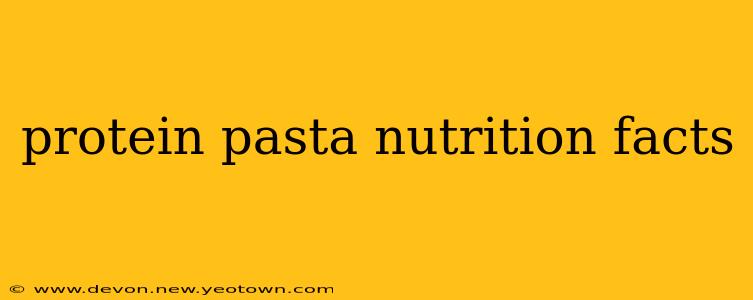Pasta night just got a protein-packed upgrade! For years, pasta has been a staple in kitchens worldwide, but its reputation for being a simple carbohydrate source is evolving. Enter protein pasta, a culinary innovation offering a healthier, more satiating twist on a classic. But what exactly are the nutritional facts behind this rising star? Let's unravel the details and explore the benefits of incorporating protein pasta into your diet.
What are the Nutritional Differences Between Protein Pasta and Regular Pasta?
This is a key question many people have. The most significant difference lies, unsurprisingly, in the protein content. Regular pasta, typically made from wheat, is primarily a source of carbohydrates. Protein pasta, however, incorporates ingredients like lentils, chickpeas, soy, or even pea protein, dramatically increasing its protein content. This boost in protein means you get a more substantial, longer-lasting feeling of fullness, helping to manage hunger and potentially aiding in weight management. While the carb count might still be present, the added protein alters the glycemic index, leading to a slower release of sugar into the bloodstream. This is beneficial for those managing blood sugar levels. The fiber content is also often higher in protein pasta compared to its traditional counterpart.
Is Protein Pasta Lower in Calories Than Regular Pasta?
Not necessarily. While the protein content is higher, the calorie count can vary significantly depending on the specific brand and type of protein pasta. Some varieties may have a comparable calorie count to regular pasta, while others might be slightly higher or lower. Always check the nutritional information on the specific package you purchase. The nutritional value isn't solely determined by the calories; the macronutrient breakdown (protein, carbs, and fat) is crucial in assessing its overall health benefits. The increased protein content is often the primary driver of its health benefits, regardless of minor calorie fluctuations.
How Much Protein is in a Serving of Protein Pasta?
This varies widely. A single serving of protein pasta can contain anywhere from 15 to 30 grams of protein, depending on the brand and the type of protein source used. For comparison, a serving of regular pasta typically contains significantly less, in the range of 5-7 grams. Always check the nutritional label for precise information as this is a crucial determining factor in its nutritional value. This higher protein content contributes to satiety, making it a more filling meal option, which is particularly helpful for individuals aiming to control their caloric intake.
What are the Benefits of Eating Protein Pasta?
The benefits extend beyond simply increased protein. The higher fiber content can promote healthy digestion and regularity. The slower release of sugar into the bloodstream helps to regulate blood sugar levels, which is beneficial for individuals with diabetes or those aiming to manage their blood sugar more effectively. Furthermore, the increased protein content contributes to muscle growth and repair, making it a good option for athletes or individuals engaging in regular physical activity.
Is Protein Pasta Gluten-Free?
Not always. While many protein pasta options are gluten-free (particularly those made from lentils, chickpeas, or peas), some may contain gluten depending on the ingredients used. Carefully check the packaging for a clear gluten-free label to ensure it aligns with your dietary needs. Many individuals opt for protein pasta precisely because they are seeking a gluten-free alternative to traditional wheat-based pasta.
Does Protein Pasta Taste Different Than Regular Pasta?
The taste can vary depending on the brand and the type of protein used. Some protein pastas maintain a very similar texture and taste to traditional pasta, while others may have a slightly different flavor profile, often with a nuttier or earthier undertone. Experimenting with different brands is often the best way to find a protein pasta that aligns with your personal preferences. This subtle difference in taste shouldn't deter you from trying this healthier alternative!
By understanding the nutritional facts and benefits of protein pasta, you can make an informed decision about integrating it into your diet. Remember to always check the nutritional label for accurate information relevant to the specific brand and type of protein pasta you choose to buy. Happy cooking!

